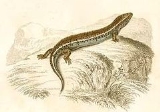
Chalcides ocellatus
Encyclopedia
Chalcides ocellatus, or Ocellated Skink (also known as Eyed Skink or gongilo) is a species of skink
found in Greece
, southern Italy
, Malta
, and parts of northern Africa
.
.jpg) As an adult, it generally reaches about 6 to 12 inches of length and has a small head, cylindrical body, and five toes on each foot. They are very agile and are often found in arid areas. It is strongly related to Chalcides colosii
As an adult, it generally reaches about 6 to 12 inches of length and has a small head, cylindrical body, and five toes on each foot. They are very agile and are often found in arid areas. It is strongly related to Chalcides colosii
, and C. colosii was formerly considered a subspecies of C. ocellatus. C. ocellatus is notable for the presence of ocelli
and for its wide variety of coloration patterns. It preys on various insects, including those with hard exoskeleton
s, arachnids, and small lizards, including its own young. In captivity it also eats sweet fruit
s, boiled eggs
and pieces of meat
. Females of the species give birth to live young through vivipary
.
C. ocellatus is considered to be a generalist species
and can be found in a wide variety of environments, such as farmland and gravel deserts around the Mediterranean coast. Its main escape tactic from predators is to run behind vegetation, most likely because it is not suited to run very fast. Its limbs are somewhat short, but not adapted for fossorial
movement.
Skink
Skinks are lizards belonging to the family Scincidae. Together with several other lizard families, including Lacertidae , they comprise the superfamily or infraorder Scincomorpha...
found in Greece
Greece
Greece , officially the Hellenic Republic , and historically Hellas or the Republic of Greece in English, is a country in southeastern Europe....
, southern Italy
Italy
Italy , officially the Italian Republic languages]] under the European Charter for Regional or Minority Languages. In each of these, Italy's official name is as follows:;;;;;;;;), is a unitary parliamentary republic in South-Central Europe. To the north it borders France, Switzerland, Austria and...
, Malta
Malta
Malta , officially known as the Republic of Malta , is a Southern European country consisting of an archipelago situated in the centre of the Mediterranean, south of Sicily, east of Tunisia and north of Libya, with Gibraltar to the west and Alexandria to the east.Malta covers just over in...
, and parts of northern Africa
Africa
Africa is the world's second largest and second most populous continent, after Asia. At about 30.2 million km² including adjacent islands, it covers 6% of the Earth's total surface area and 20.4% of the total land area...
.
.jpg)
Chalcides colosii
Chalcides colosii, also known as the Riffian Skink or Colosi's Cylindrical Skink, is a moderately-sized species of skink found in Morocco and some Spanish territories. It is named after Giuseppe Colosi, former director of the Zoological Institute of the University of Florence. It was once...
, and C. colosii was formerly considered a subspecies of C. ocellatus. C. ocellatus is notable for the presence of ocelli
Eyespot (mimicry)
An eyespot is an eye-like marking. They are found on butterflies, reptiles, birds and fish. In members of the Felidae family , the white circular markings on the backs of the ears are termed ocelli, and they are functionally similar to eyespots in other animals.Eyespots may be a form of...
and for its wide variety of coloration patterns. It preys on various insects, including those with hard exoskeleton
Exoskeleton
An exoskeleton is the external skeleton that supports and protects an animal's body, in contrast to the internal skeleton of, for example, a human. In popular usage, some of the larger kinds of exoskeletons are known as "shells". Examples of exoskeleton animals include insects such as grasshoppers...
s, arachnids, and small lizards, including its own young. In captivity it also eats sweet fruit
Fruit
In broad terms, a fruit is a structure of a plant that contains its seeds.The term has different meanings dependent on context. In non-technical usage, such as food preparation, fruit normally means the fleshy seed-associated structures of certain plants that are sweet and edible in the raw state,...
s, boiled eggs
Egg (food)
Eggs are laid by females of many different species, including birds, reptiles, amphibians, and fish, and have probably been eaten by mankind for millennia. Bird and reptile eggs consist of a protective eggshell, albumen , and vitellus , contained within various thin membranes...
and pieces of meat
Meat
Meat is animal flesh that is used as food. Most often, this means the skeletal muscle and associated fat and other tissues, but it may also describe other edible tissues such as organs and offal...
. Females of the species give birth to live young through vivipary
Vivipary
Vivipary has two different meanings. In animals, it means development of the embryo inside the body of the mother, eventually leading to live birth, as opposed to laying eggs...
.
C. ocellatus is considered to be a generalist species
Generalist and specialist species
A generalist species is able to thrive in a wide variety of environmental conditions and can make use of a variety of different resources . A specialist species can only thrive in a narrow range of environmental conditions or has a limited diet. Most organisms do not all fit neatly into either...
and can be found in a wide variety of environments, such as farmland and gravel deserts around the Mediterranean coast. Its main escape tactic from predators is to run behind vegetation, most likely because it is not suited to run very fast. Its limbs are somewhat short, but not adapted for fossorial
Fossorial
A fossorial organism is one that is adapted to digging and life underground such as the badger, the naked mole rat, and the mole salamanders Ambystomatidae...
movement.

